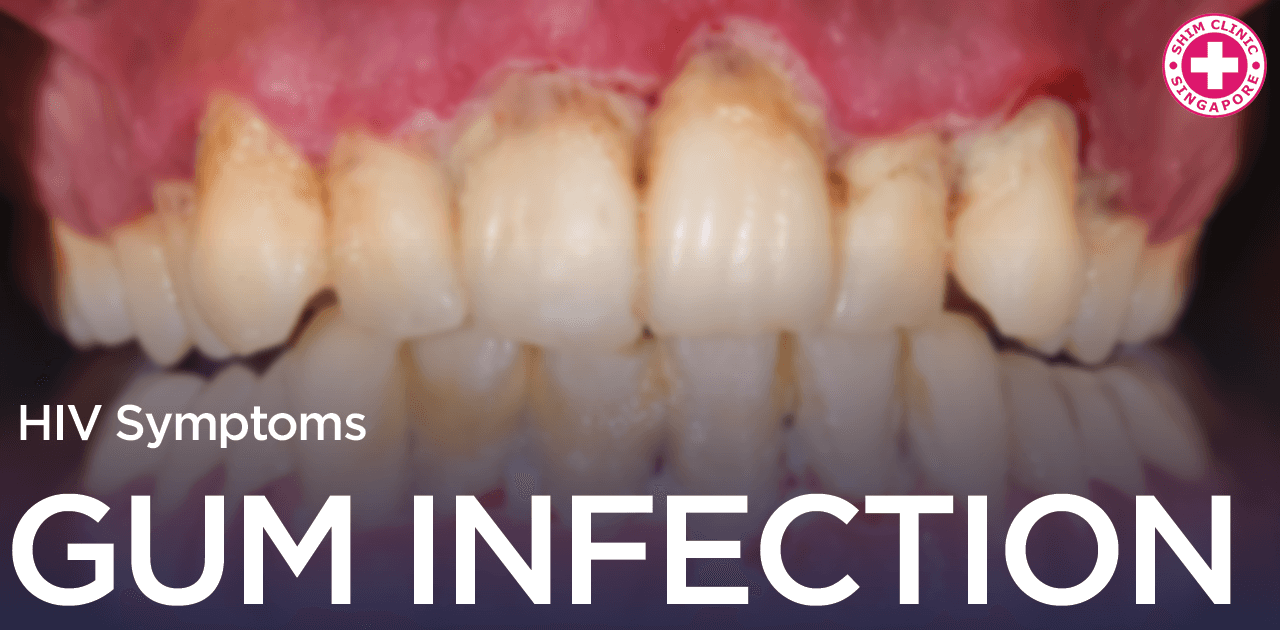HIV Gum Infection Singapore | Shim Clinic
| Help me about HIV Gum Infection ! |

| Permalink: https://shimclinic.sg/hiv-gum-infection |
Healthy gums are flat and light pink. A gum infection causes gums to be swollen or brighter red, and this is called gingivitis. Smoking, diabetes, hormonal changes, and infectious diseases can cause a higher risk of gingivitis. Swollen gums can be a symptom of early or late HIV infection.
Healthy gums are flat and light pink. If the gums are swollen or brighter red, this indicates a gum infection, also known as gingivitis. This gum infection is caused by increased bacteria growing in the area; bacteria are normally present in the mouth, but when too many of them grow around the gums, then gingivitis results. Infected gums may be sore or sensitive, and may bleed easily (for example, when flossing normally, there may be bleeding of the gums). A severe gum infection is known as periodontitis. When a gum infection is chronic and untreated, it can lead to loss of teeth and thinning of the bone of the jaw.
There are several risk factors for gum infection. Smoking causes a higher risk, as does diabetes, especially if it’s not well-controlled. Hormonal changes in women around pregnancy and menopause can make the gums more likely to get infected. Many different medications can also cause this symptom. In addition, HIV is associated with infected gums.
- Healthy gums are flat and light pink. Swollen or brighter red gums are infected. This is called gingivitis.
- Smoking, diabetes, hormonal changes, and infectious diseases can cause a higher risk of gingivitis.
- Swollen gums can also be a symptom of early or late HIV infection.
- It’s not possible to definitively diagnose HIV without an HIV test.
- Because the early symptoms of HIV are similar to those of many common viral illnesses, a doctor won’t suspect HIV if you hide your sexual behavior from your doctor. Make sure you disclose any possible HIV exposures to get the right diagnosis and treatment.
The early phase of HIV infection causes a flu-like illness in many people. Swollen gums can be a symptom of this phase of the infection, along with many other symptoms, including fever, nausea, and sore throat. After this, the virus enters a latency period, where there are no symptoms for several years. Those who didn’t see a doctor during the early flu-like illness, or whose symptoms were mild or absent during this phase, may not know that they have HIV. Later, HIV will start to cause other infections to take hold in the body. The mouth is often the first part of the body to show symptoms of this phase, with infections like thrush, a fungal infection of the mouth that’s rare in people with healthy immune systems.
Although the presence of several unusual infections may cause a doctor to highly suspect HIV, the only way to definitively diagnose HIV is through an HIV test. There are other conditions that impair the immune system, so HIV cannot be assumed. In the early phase of the infection, the flu-like symptoms are similar to those of many other common infectious diseases. A doctor may not even suspect that these are actually HIV symptoms, unless the patient discloses any risky behavior that could have caused an HIV exposure. Keeping secrets from your doctor is never a good idea and could put your life at risk by preventing your doctor from making an accurate diagnosis. Make sure that you tell your doctor about any potential HIV exposures, such as a condom breaking or slipping during sex. This will make sure that you get the HIV test you need.
Sources:
Mayo Clinic. “STD symptoms: Common STDs and their symptoms.” Mayo Clinic. Published 18 Mar 2015. Accessed 20 Jul 2016. http://www.mayoclinic.org/std-symptoms/art-20047081
Centers for Disease Control and Prevention. “Screening Recommendations Referenced in Treatment Guidelines and Original Recommendation Sources.” Centers for Disease Control and Prevention. Published 04 Jun 2015. Accessed 20 Jul 2016. http://www.cdc.gov/std/tg2015/screening-recommendations.htm
Centers for Disease Control and Prevention. “HIV/AIDS.” Centers for Disease Control and Prevention. Published 05 Jul 2016. Accessed 27 Jul 2016. http://www.cdc.gov/hiv/
Centers for Disease Control and Prevention. “HIV Basics – Testing.” Centers for Disease Control and Prevention. Published 12 Jul 2016. Accessed 20 Jul 2016. http://www.cdc.gov/hiv/basics/testing.html
U.S. Department of Health & Human Services. “Post-Exposure Prophylaxis (PEP).” AIDS.gov. Published 21 Sep 2015. Accessed 20 Jul 2016. https://www.aids.gov/hiv-aids-basics/prevention/reduce-your-risk/post-exposure-prophylaxis/
| Timeline | HIV | STD | Pregnancy |
|---|---|---|---|
| Before exposure | |||
| Contraception (females only) | |||
| HIV PrEP (pre-exposure prophylaxis) - Stop HIV infection before exposure | STD vaccine: - Hepatitis vaccine - HPV vaccine | ||
| STD / HIV exposure | |||
| 0-72 hours | HIV PEP (post-exposure prophylaxis) - Stop HIV infection after exposure | STD testing * - Screening test - to look for asymptomatic infections - from previous exposures | Emergency contraception with the morning-after pill (females only) |
| 2 weeks | HIV DNA Test | ||
| 1 month | HIV 4th Generation Test - SD Bioline HIV Ag/Ab Combo - Fingerprick blood sampling. - 20 minutes to results | ||
| 3 months | HIV 3rd Generation Test - OraQuick® HIV-1/2 Antibody - Oral fluid or - Fingerprick blood sampling. - 20 minutes to results | STD testing * - Full & comprehensive - diagnostic test - to look for current infections | |
| Watch for | HIV Symptoms | STD Symptoms | |
| If infected | HIV Treatment | STD Treatment | Abortion |
References